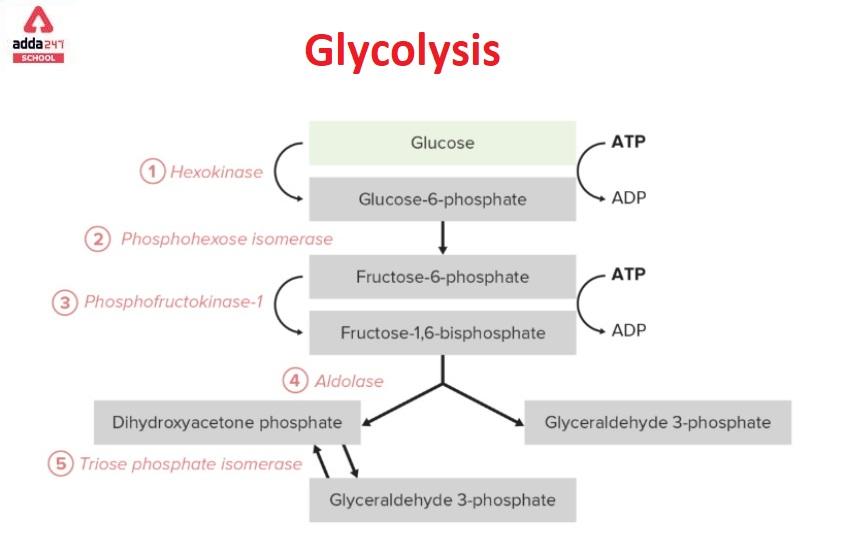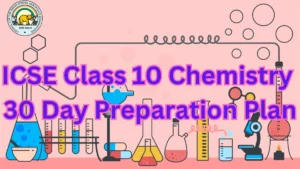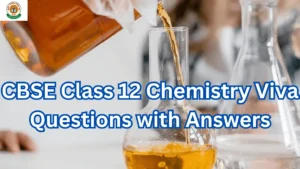Table of Contents
Glycolysis
Glycolysis is a metabolic mechanism that transforms glucose (C6H12O6) to pyruvic acid (CH3COCOOH) without the use of oxygen. The high-energy molecules are formed using the free energy produced during this process. Adenosine triphosphate and reduced nicotinamide adenine dinucleotide are two high-energy compounds. Glycolysis is made up of ten different reactions. It is also catalyzed by enzymes. Even the reactions that make glycolysis and its parallel pathway, the pentose phosphate pathway, occur in the oxygen-free circumstances of the Archean oceans, in the lack of enzymes, and in the absence of metal-catalyzed reactions, indicating that glycolysis is an ancient metabolic pathway.
Explain Glycolysis
Glycolysis takes place in the liquid section of cells in most organisms. The cytosol is the liquid component of cells. The Embden–Meyerhof–Parnas (EMP) pathway is the most common type of glycolysis. Gustav Embden, Otto Meyerhof, and Jakub Karol Parnas discovered the Embden–Meyerhof–Parnas (EMP) pathway. The Entner–Doudoroff pathway, as well as several heterofermentative and homofermentative processes, are examples of other Glycolysis pathways.
Explain The Glycolysis in detail
Glycolysis is a series of enzymatic reactions that converts one molecule of glucose into two molecules of pyruvate. This metabolic pathway is central to both aerobic and anaerobic respiration in cells. Glycolysis takes place in the cytoplasm and does not require oxygen.
Overview of Glycolysis Steps
Phase 1: Energy Investment Phase
- Glucose to Glucose-6-Phosphate: The enzyme hexokinase catalyzes the phosphorylation of glucose using a molecule of ATP, converting it to glucose-6-phosphate.
- Glucose-6-Phosphate to Fructose-6-Phosphate: The enzyme phosphoglucoisomerase converts glucose-6-phosphate into fructose-6-phosphate.
- Fructose-6-Phosphate to Fructose-1,6-Bisphosphate: The enzyme phosphofructokinase uses another ATP to convert fructose-6-phosphate to fructose-1,6-bisphosphate.
Phase 2: Cleavage Phase
- Fructose-1,6-Bisphosphate to Glyceraldehyde-3-Phosphate and Dihydroxyacetone Phosphate: The enzyme aldolase cleaves fructose-1,6-bisphosphate into two three-carbon molecules: glyceraldehyde-3-phosphate (G3P) and dihydroxyacetone phosphate (DHAP).
- Dihydroxyacetone Phosphate to Glyceraldehyde-3-Phosphate: The enzyme triose phosphate isomerase converts DHAP into G3P. Now, there are two molecules of G3P.
Phase 3: Energy Generation Phase
- Glyceraldehyde-3-Phosphate to 1,3-Bisphosphoglycerate: The enzyme glyceraldehyde phosphate dehydrogenase converts G3P to 1,3-bisphosphoglycerate, generating NADH in the process.
- 1,3-Bisphosphoglycerate to 3-Phosphoglycerate: A molecule of ATP is generated by substrate-level phosphorylation. The enzyme phosphoglycerate kinase facilitates this step.
- 3-Phosphoglycerate to 2-Phosphoglycerate: The enzyme phosphoglycerate mutase rearranges 3-phosphoglycerate into 2-phosphoglycerate.
- 2-Phosphoglycerate to Phosphoenolpyruvate: The enzyme enolase removes a water molecule, converting 2-phosphoglycerate to phosphoenolpyruvate (PEP).
- Phosphoenolpyruvate to Pyruvate: Another molecule of ATP is generated by substrate-level phosphorylation. The enzyme pyruvate kinase facilitates this conversion.
Summary of Energy Balance
- Input: 2 ATP
- Output: 4 ATP, 2 NADH, 2 pyruvate
Net Gain:
- 2 ATP
- 2 NADH
- 2 pyruvate
This is a simplified overview, but glycolysis is a highly regulated and intricate process that plays a foundational role in cellular metabolism.
Glycolysis is also Known as EMP
The EMP route is another name for glycolysis. The partial oxidation of glucose results in the formation of two molecules of pyruvic acid. Glycolysis takes place in the cell’s cytoplasm. It can be found in practically every living organism. It is the only process of respiration in anaerobic organisms.
Glycolysis Cycle Diagram
The Glycolysis Cycle Diagram is very important to understand the whole process of glycolysis.
Source: Wikipedia

Glycolysis Pathway with Diagram
Glycolysis takes place in the cytoplasm. It generates energy by breaking down glucose into two three-carbon molecules; the glucose is trapped by phosphorylation with the help of the enzyme hexokinase. In this reaction, adenosine triphosphate (ATP) is employed. Hexokinase is inhibited by the product glucose-6-P. Glycolysis is a ten-step process. Five of the ten steps are in the planning stage, while the other five are in the execution stage. Phosphofructokinase is the rate-limiting enzyme, and ATP is produced by high-energy molecules phosphorylating the substrate at the molecular level.
All cells in the body employ glycolysis to generate energy, and the end product of glycolysis is pyruvate in aerobic conditions and lactate in anaerobic ones. Pyruvate also participates in the Krebs cycle, which produces more energy.
Glycolytic Pathway Diagram:

Source: Wikipedia
Glycolysis: Krebs cycle
The Krebs cycle is a set of chemical events that releases energy that has been stored in the body. The oxidation of acetyl-CoA obtained from carbs, lipids, and proteins provides this stored energy. Organisms that respire use the Krebs cycle to generate energy. The cycle produces amino acid precursors as well as the reducing agent NADH. Its key role in numerous metabolic pathways shows that it was one of metabolism’s early components. Despite the fact that it is referred to as a ‘cycle,’ metabolites do not have to follow a single path. There are at least three different parts of the citric acid cycle that have been identified.
Citric acid is the source of this metabolic pathway’s name. Citric acid, often known as citrate, is a tricarboxylic acid. This series of reactions consume it and then regenerates it to complete the cycle. Acetate is used in the form of acetyl-CoA and water through the cycle. It then converts NAD+ to NADH, producing carbon dioxide in the process. The citric acid cycle generates NADH, which is then fed into the oxidative phosphorylation route, also known as the electron transport pathway. The oxidation of foods to produce usable chemical energy is the end outcome of these two closely related mechanisms. ATP is the chemical energy that can be used.
Glycolysis Reaction Result
Glycolysis begins with a molecule of glucose and concludes with two molecules of pyruvate or pyruvic acid. There are also four ATP molecules and two NADH molecules. In the first half of the route, two ATP molecules were employed. They were employed to prepare the six-carbon ring for cleavage in the first half of the pathway. As a result, the cell gains two ATP molecules and two NADH molecules for utilisation. If the cell is unable to further catabolize the pyruvate molecules, it will only be able to extract two ATP molecules from a single molecule of glucose.
Glycolysis Cycle Example
Question:
Which enzyme catalyzes the conversion of Fructose-6-Phosphate to Fructose-1,6-Bisphosphate in glycolysis?
a) Hexokinase
b) Phosphoglucose Isomerase
c) Phosphofructokinase
d) Aldolase
Answer:
c) Phosphofructokinase
Solution:
The enzyme that catalyzes the conversion of Fructose-6-Phosphate to Fructose-1,6-Bisphosphate is Phosphofructokinase. This is the third step in the glycolysis pathway and is a key regulatory step. Therefore, the correct answer is option c.
Related Post:



 CUET Chemistry Syllabus 2025, Download O...
CUET Chemistry Syllabus 2025, Download O...
 ICSE Class 10 Chemistry 30 Day Preparati...
ICSE Class 10 Chemistry 30 Day Preparati...
 CBSE Class 12 Chemistry Viva Questions w...
CBSE Class 12 Chemistry Viva Questions w...










